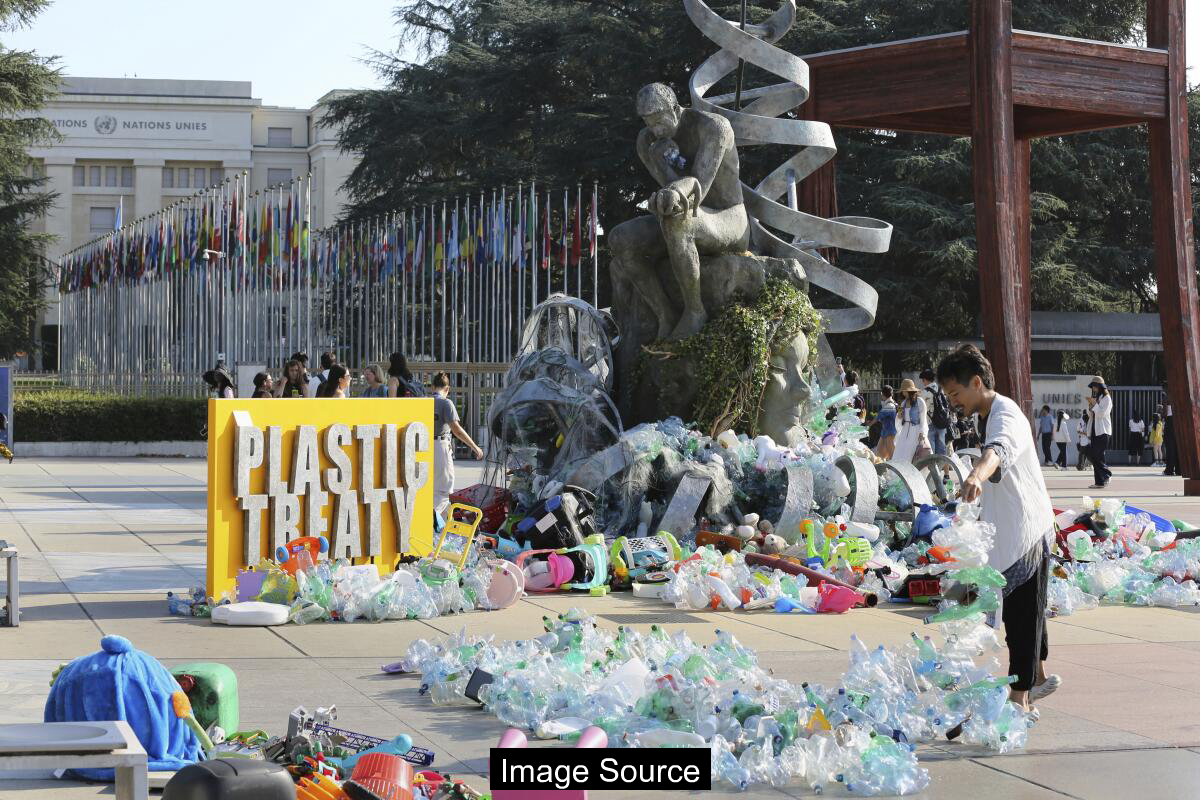A provocative art installation at the United Nations headquarters in New York City aims to draw global attention to the mounting environmental challenge of plastic pollution. The artwork, which involves encasing a prominent sculpture in discarded plastic materials, serves as a stark visual metaphor for the growing waste crisis threatening marine ecosystems and global sustainability.

Global Plastic Treaty Negotiations Spotlight Urgent Environmental Challenge
Delegates from 184 countries have converged in Geneva to draft the first legally binding global treaty addressing plastic pollution. The high-stakes negotiations involve approximately 3,700 participants representing over 600 organizations, underscoring the international community’s recognition of this critical environmental issue. Participants are working to develop comprehensive strategies to mitigate the growing plastic waste crisis.
The complexity of these negotiations is evident in the numerous unresolved disagreements that persist. European Commissioner Jessika Roswall has expressed concern about the slow pace of progress, emphasizing the urgent need for concrete results. United Nations Environment Programme Executive Director Inger Andersen remains optimistic, stating that a meaningful treaty remains achievable.
The negotiations represent a pivotal moment in global environmental policy, with potential far-reaching implications for sustainable development and ecological preservation. Stakeholders are grappling with intricate challenges related to plastic production, waste management, and long-term environmental impact.
Art as Environmental Advocacy
Canadian artist and activist Benjamin Von Wong has transformed the negotiation landscape with his powerful sculptural installation titled ‘Thinker’s Burden’. Positioned strategically in front of the UN office, the nearly 18-foot sculpture serves as a provocative visual metaphor for humanity’s environmental responsibility. Inspired by Auguste Rodin’s famous ‘The Thinker’, Von Wong’s artwork depicts a male figure sitting atop Mother Earth, cradling a baby and surrounded by plastic waste.
The sculpture’s design incorporates a symbolic strand of DNA, highlighting the profound health implications of plastic pollution. Throughout the negotiations, Von Wong and volunteers are progressively adding plastic waste to the installation, creating a visceral representation of environmental degradation. Each added piece of plastic symbolizes the mounting consequences of inaction.
Maria Ivanova, an international environmental governance expert from Northeastern University, emphasizes the critical role of art in policy transformation. ‘People don’t change their minds because of facts. They do because of feelings,’ Ivanova explains, underscoring the emotional power of artistic interventions in driving environmental awareness.
Understanding Plastic Pollution’s Global Impact
Plastic pollution represents a multifaceted global challenge with significant environmental, health, and economic ramifications. The pervasive nature of plastic waste affects marine ecosystems, terrestrial environments, and human health through complex interconnected mechanisms. Scientists have documented widespread contamination across diverse global ecosystems.
The environmental consequences extend beyond immediate visible pollution. Microplastics have been discovered in remote locations, including Arctic ice and deep ocean trenches. These microscopic particles enter food chains, potentially causing long-term biological disruptions and health risks.
The economic implications are equally substantial. Plastic waste management requires significant financial investments, and the environmental cleanup costs continue to escalate. Industries worldwide are increasingly recognizing the need for sustainable alternatives and circular economy approaches.
FAQ: Plastic Pollution Treaty Insights
Q1. What makes this global plastic treaty significant?
A1. This will be the first legally binding international agreement specifically targeting plastic pollution, potentially establishing standardized regulations and commitments across participating nations.
Q2. How long might treaty implementation take?
A2. While negotiations are ongoing, experts anticipate a multi-year process involving ratification, policy development, and gradual implementation across different countries and economic sectors.
Diplomatic Challenges and Collaborative Potential
The plastic pollution treaty negotiations reveal complex diplomatic dynamics. Participating countries bring diverse economic interests, technological capabilities, and environmental priorities to the discussion. Balancing these varied perspectives requires nuanced diplomatic negotiations and compromise.
Developed nations often possess more advanced waste management technologies and resources, while developing countries may prioritize economic growth alongside environmental considerations. Bridging these perspectives demands innovative solutions and equitable frameworks.
International collaboration emerges as a critical strategy. Successful treaty implementation will require coordinated efforts, technology transfer, and supportive financial mechanisms. Multilateral cooperation can transform this environmental challenge into an opportunity for sustainable innovation.
Strategic Summary
The ongoing plastic pollution treaty negotiations represent a critical juncture in global environmental policy. Artists like Benjamin Von Wong and diplomatic representatives are collaboratively raising awareness and seeking transformative solutions to address this complex challenge.
Success will depend on sustained commitment, innovative approaches, and a shared recognition of plastic pollution’s profound environmental and health implications. The treaty’s potential impact extends far beyond immediate waste management, promising fundamental shifts in global production and consumption patterns.
As negotiations continue, the international community stands at a pivotal moment. The choices made in Geneva will significantly influence future environmental sustainability, demonstrating humanity’s capacity for collective problem-solving and ecological stewardship.
※ This article summarizes publicly available reporting and is provided for general information only. It is not legal, medical, or investment advice. Please consult a qualified professional for decisions.
Source: latimes.com